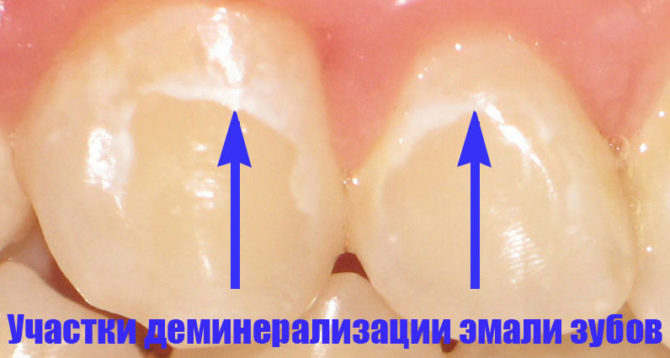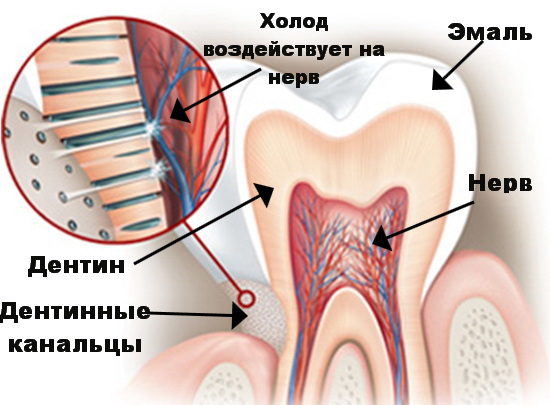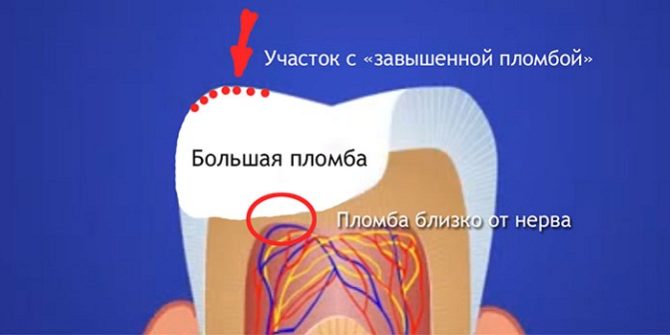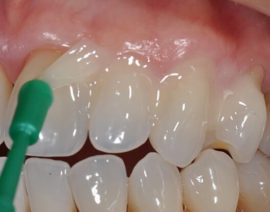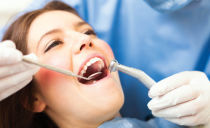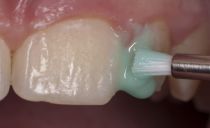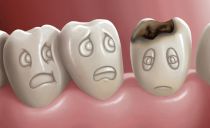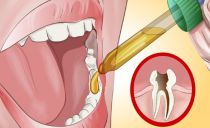Teeth respond to cold and hot: reasons and what to do
Such a problem as a painful reaction of teeth to thermal irritation is common, therefore, it has been well studied. Information about this phenomenon will help a person understand what to do if the teeth react to cold and hot: apply folk remedies, medications or consult a doctor. It is possible to get rid of hyperesthesia in different ways, the choice of the correct method depends on the cause of its occurrence.
Content
Why teeth react to cold or hot
Hyperesthesia is an increased sensitivity to external influences. If a person has a painful reaction of teeth to cold or hot, then they talk about dental hyperesthesia. Two types are distinguished by distribution:
- localized when several teeth hurt;
- generalized when pain affects the entire jaw.
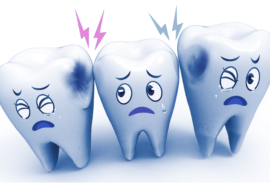 Except in cases of injury, hypersensitivity develops gradually. In total, three stages of the disease are classified:
Except in cases of injury, hypersensitivity develops gradually. In total, three stages of the disease are classified:
- The teeth began to respond to cold and hot. After eliminating the irritant, the pain quickly passes, the person completely ceases to feel it in just a minute.
- Teeth hurt when eating acidic or salty foods. When rinsing the mouth, the pain and sensation of aches go away.
- To the previous symptoms were added pain from a mild mechanical effect. A person feels pain that does not go away for a long time.
The causes of hyperesthesia are divided into unsystematic and systemic. The first include all problems that are associated with the abrasion of enamel, the appearance of porous areas or cracks on it, and damage to the crown. The use of acid-containing products, improper selection of toothpaste or poorly performed dental procedures for treatment, filling, grinding or whitening may lead to such manifestations.
The systemic causes of toothache from cold or hot food are associated with common diseases that begin to lead to a lack of elements that are important for maintaining the quality of tooth enamel. These can be gastrointestinal diseases, viral pathologies, hormonal disorders or toxicosis during pregnancy.
The mechanism of the painful reaction
The processes of pain when exposed to cold and heat are different. The decomposition of the internal tissues of the tooth leads to the appearance of a cavity filled with air with a predominant content of methane. When exposed to high temperature, the gas expands and compresses the nerve, as a result of which you can feel pain. Such a reaction indicates the need to consult a dentist, because in this case one cannot do without medical assistance.
Hypersensitivity to cold can be due to several reasons:
- Mechanical damage with exposure of nerve endings. In this case, cold food, water and air cause a nerve reaction that is only partially covered by the crown.
- Thinning of the enamel, which is responsible for protecting the internal tissues of the tooth, leads to a physical reaction of the pulp to the cold, which is transmitted to the nerve endings.
- Exposure of the neck of the tooth. This area is covered with a thin layer of enamel, and cold, penetrating through it, causes a pulp reaction.
If the tooth responds to cold and hot after filling
If the tooth began to respond to cold after filling and turning, and this reaction continues for three days after the tooth has been treated, there may be such problems:
- The presence of free space under the seal. This means that a filled tooth will have to be treated again.
- Over-sharpened tooth. It is necessary to seal it with special material.
Clinic treatment
Without the help of a dentist, it will not be possible to eliminate the problem if the tooth begins to decay, or a person feels pain throughout the jaw (generalized hyperesthesia). Treatment is also necessary if a recently cured and sealed tooth breaks or responds to a cold tooth. This can happen for the following reasons:
- improperly supplied filling material;
- filling was carried out without caries treatment, eliminating inflammation under the crown, cleaning the canals, or infection occurred under the seal during the procedure for its installation;
- a sealed tooth was physically exposed in the first hours after a seal was placed.
In dentistry, special procedures are provided aimed at strengthening the enamel of problem or highly sharpened teeth and the prevention of hyperesthesia:
-
fluorination of enamel with the application of fluorine-containing varnish or by electrophoresis;
- enamel overlapping with special filling material: it can be used in the complete absence of caries or with a slight carious lesion;
- the appointment of special applications based on calcium glycerophosphate or mineral solutions;
- appointment of an orthodontist consultation to correct the bite.
In the event that there are no obvious dental reasons for hypersensitivity to cold or heat, you need to contact a therapist who will prescribe an additional examination. Without eliminating the underlying disease, hyperesthesia cannot be cured.
The use of drugs
Using special gels can significantly reduce tooth sensitivity. They stop pain, contain substances necessary to strengthen the enamel and create a temporary protective film. They help in the first period after treatment, when a filled tooth just begins to respond to cold and hot. In addition to eliminating the painful reaction to thermal changes, modern gels contribute well to the prevention of caries and periodontitis.
The following gels are the most popular and common in pharmacies:
- Emofluor is used for gum disease.
- O.C.S. helps to brighten enamel.
- Fluoridex can be used in children by brushing it on its teeth.
Desensitizing pastes have a good effect. It is better to choose them after consultation with the dentist, since it is impossible to constantly use medical paste. Such products contain fluoride, promote enamel remineralization and have low abrasiveness.
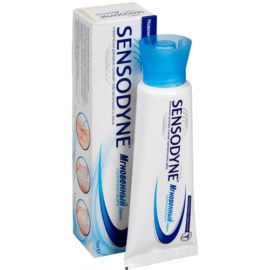 The following pastes are popular:
The following pastes are popular:
- Lacalut Sensitive with aminofluoride and sodium fluoride as active ingredients.
- Sensodyne, which contains potassium chloride and removes the problem of open dentinal canals over time.
- Glister, which has a good whitening property.
- President, containing calcium hydroxyapatite, which strengthens bone tissue and solves the problem of open dentinal canals.
Folk remedies for the reaction of teeth to cold and hot
If your teeth hurt from cold and hot, slightly and infrequently, then you can use proven folk remedies. To eliminate minor, but annoying pain, the following methods can be used:
- rinsing the oral cavity with a soda solution prepared from one tablespoon of the product and a standard glass of water;
- application of clove or tea tree oil, which can be done using a cotton swab;
- rinsing the mouth with a decoction prepared on the basis of oak bark: one tablespoon of raw materials per glass of water.
 Disinfection of the gums near the problem tooth helps to remove inflammation of the mucosa, which leads to exposure of the neck of the tooth. To do this, use the following methods:
Disinfection of the gums near the problem tooth helps to remove inflammation of the mucosa, which leads to exposure of the neck of the tooth. To do this, use the following methods:
- rinsing the mouth several times a day with a decoction of burdock, prepared at the rate of 250 milligrams of water per 1 tablespoon of raw materials;
- if the tooth feels cold and hot, you can make applications based on sea buckthorn oil and propolis, which are applied to the problem area in the morning and evening after eating.
Prevention of hyperesthesia
The best way to prevent hyperesthesia is to visit your dentist regularly. A qualified specialist identifies existing problems and gives recommendations on the use of medical pastes. With regular brushing and timely dental treatment, the risk of a painful reaction to temperature changes is significantly reduced.
There are a number of effective measures aimed at preventing the development of diseases of the teeth and gums. Necessary:
- Adjust the diet. It is necessary to eat foods with a high concentration of vitamins (fruits and vegetables without heat treatment), calcium (dairy products) and fluoride (fish, especially marine).
- Eliminate cold and excessively hot foods that adversely affect the enamel of sensitive teeth. You also need to abandon carbonated drinks with caffeine, which contribute to the intensive removal of calcium from the body.
- Do not neglect rinsing with herbal decoctions and anti-inflammatory infusions.
- Protect teeth (especially filled) from physical impact. With hyperesthesia, it is not recommended to click seeds and nuts.
Such a problem as an increased reaction of teeth to cold and heat should be solved immediately after its occurrence. Otherwise, the transition of mild hyperesthesia into a more severe form is possible, which is fraught with the development of complications. A qualified dentist can prescribe qualified treatment, and these recommendations must be followed. Modern methods of prevention and treatment of excessive tooth sensitivity can quickly restore the enamel and prevent the onset of pain.


